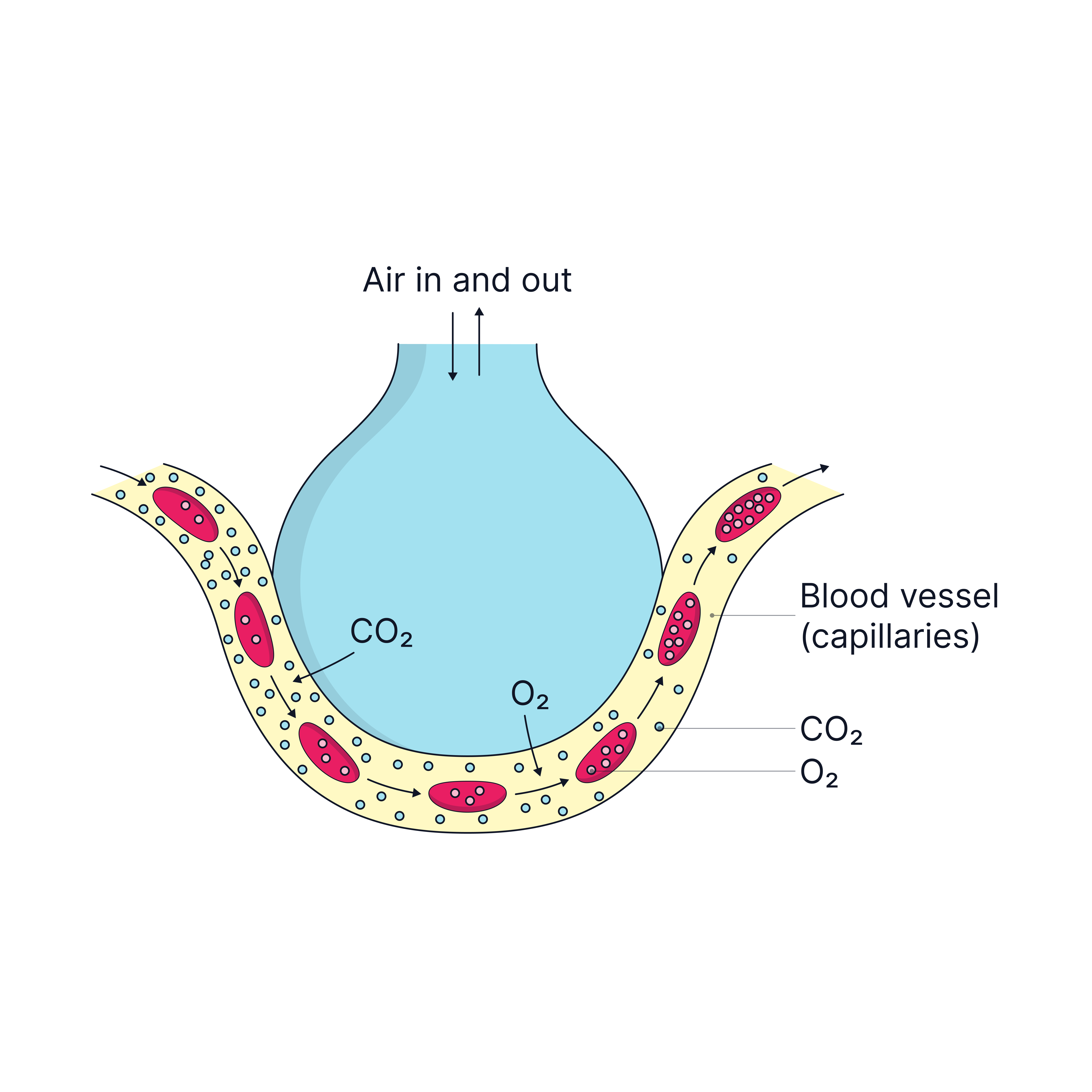The respiratory system and gas exchange in the alveoli
Laura Armstrong
Teacher

Contents
Recall Questions
This topic requires prior knowledge of the structure of the lungs (from GCSE) and the general principles of diffusion and exchange surfaces. You can test your knowledge on these below.
What is diffusion and how does it relate to gas exchange?
Diffusion is the movement of molecules from an area of high concentration to an area of low concentration. In gas exchange, oxygen diffuses from the alveoli into the blood, while carbon dioxide diffuses from the blood into the alveoli.
How is a diffusion gradient for oxygen maintained in the lungs?
Continuous ventilation of the lungs and the alveoli ensures air with a higher concentration of oxygen is always present in the lungs. Continuous circulation of blood ensures the blood in the capillaries has a lower concentration of oxygen. This maintains the diffusion gradient.
Why do alveoli have a large surface area?
A large surface area allows for more gas exchange to occur efficiently, enabling sufficient oxygen uptake and carbon dioxide removal.
Topic Explainer Video
Structure of the Human Gas Exchange System
- Trachea: Airway that carries air to the lungs; lined with ciliated epithelial cells and goblet cells that produce mucus. The trachea consists of C-shaped rings of cartilage so it does not collapse.
-
Bronchi: Two branches from the trachea leading to each lung. The walls of the bronchi also contain cartilage to keep them open.
-
Bronchioles: Smaller branches of the bronchi, leading to alveoli.
-
Alveoli: Tiny air sacs where gas exchange occurs.

Gas Exchange in the Alveoli
Oxygen diffuses across the alveolar epithelium and across the capillary endothelium into the blood by simple diffusion.
Carbon dioxide diffuses across the capillary endothelium and across the alveolar epithelium out of the blood by simple diffusion.

Adaptations of the Alveoli for Efficient Gas Exchange
- Large Surface Area: Millions of alveoli increase the surface area for diffusion.
- Thin Exchange Surface: The alveolar epithelium is one cell thick. The epithelial cells are also flattened. This provides a short diffusion pathway.
- Good Blood Supply: The alveoli are surrounded by a dense capillary network, maintaining a steep diffusion gradient. The blood carries oxygenated blood away and it is replaced with deoxygenated blood, meaning there is always a higher concentration of oxygen in the alveoli than in the blood in the lung capillaries.
- Ventilation: Regular breathing replenishes oxygen and removes carbon dioxide from the lungs, maintaining the diffusion gradient.
- Elastic fibres: The walls of alveoli contain elastic fibres, allowing them to stretch and recoil, assisting in maintaining airflow.
Key Terms
-
Diffusion: Passive movement of gases from a region of higher concentration to a region of lower concentration.
-
Ventilation: The movement of air into and out of the lungs.
Exam Tip
Remember it is the alveolar epithelium that is one cell thick (this is the wall of the alveoli) The alveoli themselves are not one cell thick!
Describe and explain how the alveoli are adapted for efficient gas exchange. (6 marks)
-
The alveoli provide a large surface area, increasing the rate of diffusion.
-
The alveolar epithelium is one cell thick, creating a short diffusion pathway.
-
The capillary endothelium is also one cell thick, reducing the diffusion distance.
-
The alveoli are surrounded by a dense network of capillaries, maintaining a steep concentration gradient for oxygen and carbon dioxide.
-
Ventilation and blood circulation continuously replace air and blood, maintaining the diffusion gradient.
-
The walls of alveoli contain elastic fibres, allowing them to stretch and recoil, assisting in maintaining airflow.
Practice Question
Try to answer the practice question from the TikTok on your own, then watch the video to see how well you did!